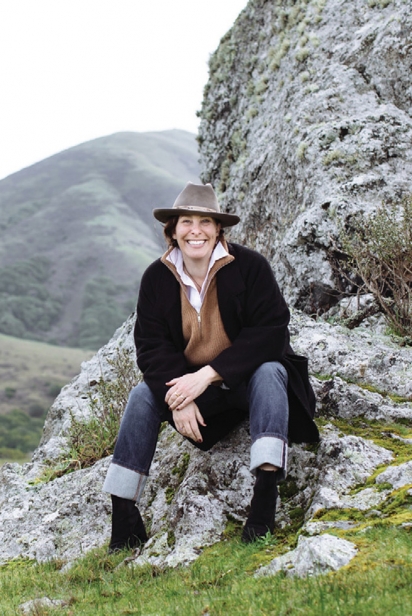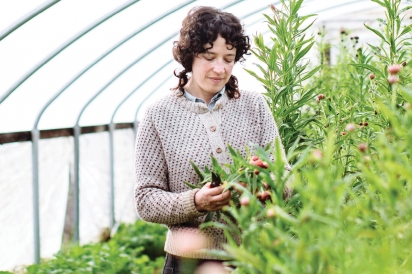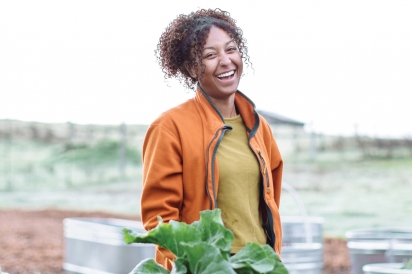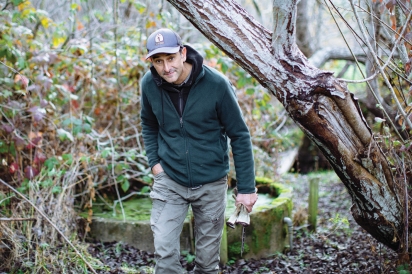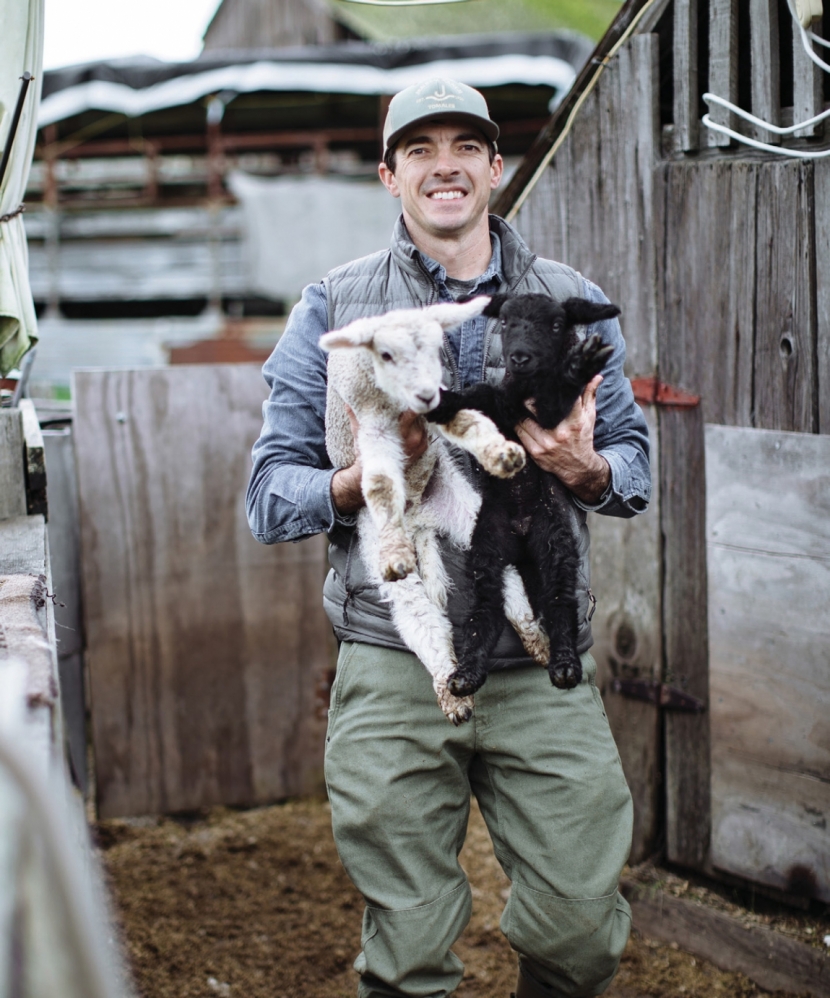Growing a Future in Agriculture - Marin’s Next Gen Farmers Make It Work
Gaze east from Highway 1 in Point Reyes Station and Black Mountain sits like a great hand, fortifying the West Marin landscape. It is a comforting, magnanimous geologic totem, the knuckles of the mountain reminding us that despite the vagaries of time—most recently drought and pandemic—the earth provides.
According to Marcel Houtzager, owner of Black Mountain Ranch, the mountain is an especially generous inactive volcano, one rife with fractured sections of basalt that hold groundwater. That water makes its way to the surface by way of springs at the base of the mountain, and those springs provide consistently for several small-scale growers on the property, even through years of drought. This auspicious natural phenomenon has helped Houtzager, who owns the ranch but is not a farmer himself, to support local “next-gen” and “first-gen” West Marin farmers and ranchers.
Houtzager works in partnership with MALT (Marin Agricultural Land Trust), a 43-year-old nonprofit with a mission that has evolved from conservation—preserving agricultural lands in Marin County by establishing conservation easements—to include the preservation of local agriculture itself. According to MALT Executive Director Lily Verdone, MALT works with landowners and the North Bay community to find creative and scalable ways to support and sustain local agriculture.
“We have a history of innovation in this area, in organic agriculture, in cheese and other products,” says Verdone. “We have the availability to test things out, and to do so we need to be creative and we need all kinds of partners.” Our collective American imagination holds a notion of the idyllic small farm, vibrant and thriving as the crops provide societal nutrition and the farmer stewards the land. As Verdone points out, West Marin is known internationally as a leader in the realm of small-scale organic and regenerative agriculture, as well as for the natural beauty these agricultural lands preserve. But the truth is that it has become tremendously difficult for local farmers and ranchers to stay in business.
“We are fortunate that the consciousness around food and the environment is here in this area,” says Arron Wilder of Table Top Farm, who cultivates four properties near Point Reyes Station including one plot on Black Mountain Ranch, “but there might not be as much knowledge about all that it actually takes to grow and sell food.”
On top of the meteorologic stressors of climate change—including periods of drought, erratic and extreme weather—the Davids of small and medium-scale agricultural hardly stand an economic chance against large-scale Goliaths: ag companies that benefit from an economy of scale and are vertically integrated to monopolize processing and distribution. It is no surprise that nationally farmers are “aging out.” According to a 2017 census study by the U.S. Department of Agriculture, 34% of farmers nationwide are over age 65 compared to approximately 8% under 35. And it is not for lack of desire to farm or ranch; in many cases farmers and ranchers hold second jobs so that they can continue to work the land.
In the North Bay, agriculture’s proximity to a wealthy, population-dense region is both a boon and a hindrance. Consumer demand for organic and sustainably grown produce, and the willingness to pay more for these products, is the lifeblood of small farms. At the same time, the cost of living and the exorbitant price of land and housing are often a deal breaker for next-gen farmers. MALT developed a particularly nimble (easy to apply, quick turnaround, not a lot of strings attached) small grant program called DRAWS, designed to support easement holders through drought years. The organization has now added a second grant program to “preserve agriculture, protect biodiversity, connect our community and build climate resilience” that is open to all Marin County agriculturalists.
“We set up the emergency initiative in 2021 to help farmers and ranchers to deal with historic drought, and we granted almost a million dollars over two years,” says MALT’s Verdone. “But everyone in ag is having a hard time, and so we have expanded the grants program. We are working with individuals, families, organizations … partners like Marcel Houtzager at Black Mountain Ranch and others, anyone interested in finding ways to push the envelope out here and support existing agricultural families as well as the next generation of farmers and ranchers.”
Here we profile five local first- and next-gen farmers and ranchers, including two who farm on Black Mountain Ranch and several who work directly with MALT and/or have benefited from the organization’s grant program.
MOLLY MYERSON
Molly Myerson, founder of Little Wing Farm, was born in New York City but (like Faith Welch, at right ) was drawn to the land. She has lived in West Marin for 16 years, farming for 10 years, first in the Bloomfield area of Sonoma and, for the past seven years, on Black Mountain Ranch.
“I sustain my business on just three acres of Black Mountain Ranch,” says Myerson, “with 98% of the revenue coming from the farm stand.” Little Wing Farm Stand, where Myerson sells seasonal produce as well as fresh and dried bouquets, is located on Point Reyes–Petaluma Road on the way to Point Reyes Station. According to Myerson, Dave Osborn (the previous owner of Black Mountain Ranch) and Marcel Houtzager (the current owner) have both offered generous terms for her lease. “It is clear that these landlords value what a farm brings to the land, beyond monetary value: improvements such as soil health, perennial plants for habitat, carbon sequestration,” says Myerson. She describes the various ranching and farming operations on the ranch as “agricultural ventures that are layered and have a synergistic relationship.”
Myerson says that she, like many farmers, is strong-willed and independent, with a “pull yourself up by the bootstraps” mentality, which makes it uncomfortable to need or request support from the government or any other institution. “But the reality is, small-scale organic farms are not on equal footing with large-scale ag,” she says. “If we want small farms to provide all of the services to our population—both social and environmental, services that are not valued in our economic system—we need to provide more resources to small farmers to make that possible.”
FAITH WELCH
“The more I do this, the more I realize I don’t know,” says Faith Welch, a 24-year-old farmer who cultivates a small plot outside of Petaluma. Welch grew up in the suburbs of Novato, but knew from the time she was in elementary school that she was meant to farm. As a child she worked in her grandfather’s backyard garden and was never happier than when she was pulling weeds and planting starts. Although she had no family history of farming (at least none that she knew of at the time; it turned out that a great-great-uncle was a peach farmer in the South), her internal gyroscope told her that she was meant to farm. Not knowing where to begin or how she would make money, she became a certified dental assistant, but spent her free time educating herself through what she calls “YouTube University,” as well as reading articles and listening to podcasts about farming.
She began experimenting with cultivation in her family’s backyard. Finally, it was her grandmother who encouraged her to take the leap.
“One day my grandmother said, ‘We are going to go on weekend farm stand adventures so you can see up close how these other people are doing it,’” says Welch. Those adventures led to a series of events that eventually afforded Welch a plot of land to farm. Fast forward a few years and Welch has quit her dental job and is a full-time farmer, cultivating and selling her produce at Tenfold Farmstand off of Red Hill Road outside Petaluma.
Welch continues to self-educate. Due to economic limitations, she currently has no employees to help with farm labor, but her grandfather now helps her to sow and weed. Welch is fueled by the sense of community that develops around a farm and farm stand, and hopes to one day make her plot a teaching farm, bringing in young people like herself who aspire to farm. She also aims to expand her cultivated area so she can generate more income and reinvest in her business, but is restrained by lack of finances the small farmer’s eternal catch-22.
“If it was about money, I wouldn’t be farming,” says Welch, laughing. “I’ve come to understand how many crops you have to grow to make any income. Doing this work is hard. At the same time, it brings a joy I can’t find anywhere else.”
BRONTE EDWARDS
Bronte Edwards founded Rainbow Family Farms Ranching Co. outside of Sebastopol with the conviction that farmers and ranchers “can be active in combating climate change while supporting animal agriculture as an asset to our communities, land health and protection.” Edwards and her wife, Liz Bell, raise mostly sheep and their business includes grazing for regenerative land practices and fire suppression, as well as producing wool and high-quality, humanely raised meat products.
As a teenager Edwards started working in the restaurant industry, learning about the food world from Santa Rosa–based celebrity chef and food justice leader Duskie Estes. Over the course of seven years in the restaurant industry, she came to understand the degree to which agriculture is the key to both fine dining and environmental protection, and that led her to enroll in the Shone Farm sustainable agriculture and natural resources program at Santa Rosa Junior College.
“After graduating I was mentored by Cindy Callahan at Bellwether Farm, and fell in love with lambs. I think this kind of mentoring is the best way for someone who is a first-generation farmer to learn the ropes pretty quickly,” says Edwards. “From there I kept going and making connections, then eventually I started my grazing business, right before the pandemic.”
Now Edwards leases several properties, offering grazing and lamb and wool products, and most recently adding 10 head of cattle. In addition to running her ranch, Edwards works with MALT as a land stewardship associate, which means she is often on the ground talking to farmers and ranchers to see what kind of support they need—financial or otherwise.
Although most of the North Bay population lives in close proximity to agriculture, according to Edwards there are ongoing misconceptions, including the idea that ranchers are well-to-do.
“A story that is very important to tell is that agriculture is a cash-poor business,” says Edwards, who recently experienced an especially heart-breaking scenario where one of her beloved sheep dogs was hit by a truck on her property. She had money saved for infrastructure improvements, but put that money into vet bills as she tried to save her dog, which sadly was not possible.
“Ranchers need to be available for potential emergencies with our animals,” says Edwards. “I am lucky that my landlord has housing here for me on the farm—and that is really great, because I can be nearby and available as needed to keep my herd alive—but housing is a major issue. Young ranchers who are leasing property often aren’t able to live on-site, which makes it very difficult to catch emergencies with the animals.”
JIM JENSEN
Jim Jensen’s family has ranched in West Marin since the 1800s, making Jim and his father, Bill, sixth- and fifth-generation Marin County ranchers. “Our family has actually been ranching here since the time of the Spanish land grants,” says Jensen, 40. Today he helps manage the family’s Jensen Ranch and Tomales Sheep Company located outside of the town of Tomales, grazing sheep and cattle on several properties in the surrounding area. He also works as a land steward at the Cypress Grove Research Center at Audubon Canyon Ranch in Marshall.
Jensen, who serves on the MALT board of directors, attended Cal Poly San Luis Obispo and studied forestry and wildland fire and range management. After college he fought forest fires and worked in forestry for the National Park Service for several years before returning to West Marin. Theoretically, ranching should be easier for established landowners like Jensen and his family than it is for “first-gen” farmers, but the reality is, he and his family face the same issues as other small-scale agriculture in the region.
“Even if you come with local connections, housing is tough,” says Jensen. “And because of variables like drought and pandemic, there is too much risk to just farm; you need to maintain another career.” Jensen points out that his family’s business, primarily lamb, competes with imports from Australia and New Zealand that make up 70% of the market. And finally, he adds, inputs cost more and more, and the margin for profits hasn’t kept pace with the cost of living.
As a rancher and a land steward for the Audubon Canyon Ranch, an environmental organization, Jensen has a deeply nuanced view of conservation. “It fascinates me, this balance between the natural world and agriculture in this region,” he says.
ARRON WILDER
Arron Wilder, founder of Table Top Farm, has leased and farmed plots of land in and around Point Reyes Station since 2009. After 14 years farming, he recently purchased his first parcel—six acres along the Lagunitas Creek near downtown Point Reyes Station—while he continues to lease three other plots, including one at Black Mountain. The years since the pandemic have been especially unstable, and he is grateful that Table Top has stayed afloat. Like many farmers, he now holds a second job, as a ranch manager in Nicasio, “I almost went out of business in 2021. Restaurants had always been my main customers. Before the pandemic 50–80% of my produce went to restaurants,” says Wilder. “Then, during the pandemic I lost restaurant accounts and they didn’t come back. In 2020 my CSA [community-supported agriculture] subscriptions doubled, but then they dwindled again in 2021.” Wilder runs two Table Top farm stands, one at the junction of Highway 1 and Point Reyes–Petaluma Road and the other on Cypress Street in the neighborhood on the mesa above Point Reyes Station. He has a yurt and a trailer on his properties, but has been unable to use them to house farm employees due to strict local regulations.
Wilder has received a MALT grant to put in a well on his property along Lagunitas Creek, as well as a grant through SARE (Sustainable Agriculture Research and Education) to research dry farming techniques on his farm. After almost a decade and a half farming in the region, he has learned that, “Just strictly growing and selling might not make ends meet.” Like Houtzager and many others in the West Marin ag community, Wilder believes the proximity to population centers offers the region a key opportunity: the development of additional income streams for farmers, including events, demonstrations, lectures, and various forms of tourism.



